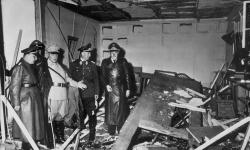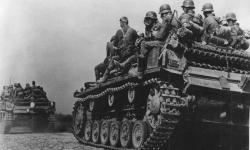The Night of the Long Knives
Key facts about the Night of the Long KnivesThe Night of the Long Knives was a purge of elements within the Nazi Party - particularly the SA paramilitary arm - and other political opponents between 30 June and 2 July 1934. Officially almost 100 people died (although it's likely to be many more) and many others were arrested.
- The Night of the Long Knives started on 30 June 1934, and lasted until 2 July 1934
- It was a purgeA removal of something, in biological terms often of something from the body, or in political terms an often violent removal of a group of people. (a violent removal of a group of people) of right-wing political opponents by the Nazi Party
- It was also used to tame the violent and radicalA person who advocates thorough or complete political or social reform, or a description of that change. paramilitaryA group organised along military lines. wing of the Nazi Party
- Up to 200 people were killed and thousands were arrested
- Many Germans, including the army and the courts, either approved or didn't resist the purge
People you need to know
- Paul von Hindenburg - German nobleman, popular military officer and president of Germany from 1925 until 1934.
- Adolf Hitler - leader of the Nazi Party and Führer of Germany.
- Franz von Papen - German nobleman, officer and politician. He was German chancellor in 1932 and vice-chancellor under Hitler in 1933–1934.
- Ernst Röhm - head of the SAShort for the Sturmabteilung, meaning 'Storm Detachment' and where the phrase 'storm trooper' comes from. They were also known as Brown Shirts, as they wore a brown uniform. Their primary purposes were providing vocal and violent protection for Nazi meetings, and disrupting, intimidating or fighting with the Nazi's opponents. and founding member of the Nazi Party.
- Gregor Strasser - an early and powerful member of the Nazi Party, who disagreed with Hitler personally and politically.
Starting on the night of the 30 June 1934, the Nazis removed their political opponents and paramilitary supporters in a single purge in what became known as the Night of the Long Knives. 
Hitler's response was codenamed Operation Hummingbird. Starting on 30 June 1934, 85 named individuals were arrested and executed without trial, including Strasser and the Vice-Chancellor, von Papen. Röhm was arrested and offered suicide in prison, which he declined, so an SSShort for Schutzstaffel, it was a major Nazi paramilitary organisation which, among other things, was primarily responsible for the implementation of the Final Solution. officer named Lippert did it for him, shooting him three times in the chest. In 1957, Lippert was tried for his role in the purge, and sentenced to 18 months in prison. While only 85 people had been targeted during the purge, the actual death toll could be as high as 150-200, with many using the opportunity to settle old arguments. Thousands more people were arrested and imprisoned, a fate often the same as death.
In 1957, Lippert was tried for his role in the purge, and sentenced to 18 months in prison. While only 85 people had been targeted during the purge, the actual death toll could be as high as 150-200, with many using the opportunity to settle old arguments. Thousands more people were arrested and imprisoned, a fate often the same as death. 
The purge finished on 2 July, leaving the Nazis with a need to present it in a sympathetic light. On 2 July, it was announced on the radio that Hitler had foiled a plot to overthrow the government, but that quick action had been taken for the safety of the state, and he was roundly applauded by the army and President Hindenburg. It is this story that gives another name to the Night of the Long Knives, the Röhm PutschA revolt or attempted overthrow of the government. (putsch meaning a revolt or rebellion against the government). When an act was passed retroactively legitimising the purge on the grounds of defence of the state, the judiciaryThe systems and people (such as judges) relating to the practice of law. did nothing to prevent it. They had therefore shown they would be compliant, which set a dangerous precedent for the regime's later atrocities. Many have pointed to the Night of the Long Knives as the point where hope of positive change in Germany died, along with Hitler's political opponents.
It is this story that gives another name to the Night of the Long Knives, the Röhm PutschA revolt or attempted overthrow of the government. (putsch meaning a revolt or rebellion against the government). When an act was passed retroactively legitimising the purge on the grounds of defence of the state, the judiciaryThe systems and people (such as judges) relating to the practice of law. did nothing to prevent it. They had therefore shown they would be compliant, which set a dangerous precedent for the regime's later atrocities. Many have pointed to the Night of the Long Knives as the point where hope of positive change in Germany died, along with Hitler's political opponents.
The violence perpetrated on the Night of the Long Knives would only escalate as the Third ReichLiterally meaning the third realm or empire. It is the name used to describe Nazi Germany, from 1933 until 1945. continued. Ironically, it was fear of violence which had been used to legitimise – and normalise – a violent act, and as the supposed enemies of the state increased during the next 10 years, so did the Nazi violence against them.
Things to think about
- Were the leaders of the SA a threat to Hitler?
- How complicit were the judiciary in the Night of the Long Knives?
- What were the lasting effects of the purge?
- What does the Night of the Long Knives tell us about Nazi Germany and the Nazi government?
- What effect did Nazi propagandaBiased and misleading information used to promote a political cause or point of view. have on public opinion, and what lessons did the Nazi leadership learn from it?
Things to do
- Look at the reaction to the Night of the Long Knives from the press around the world. This could include cartoons (such as the David Low one above) and newspaper articles. What do you think the general opinion of the purge was, inside and outside Germany?
Further reading
The best person to read to gain an understanding of Nazi Germany and Hitler is Ian Kershaw. He has written extensively on the Third Reich, but one (or two) of his best is the biography of Hitler that was first published in two parts and has now been abridged into one volume. There are few good books in print that are solely concerned with the Night of the Long Knives. Charles Rivers Editors' book, The Night of the Long Knives: The History and Legacy of Adolf Hitler's Notorious Purge of the SA, provides a very short introduction to the purge.
- Log in to post comments






